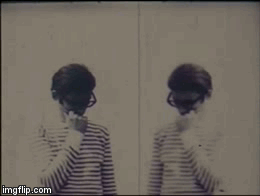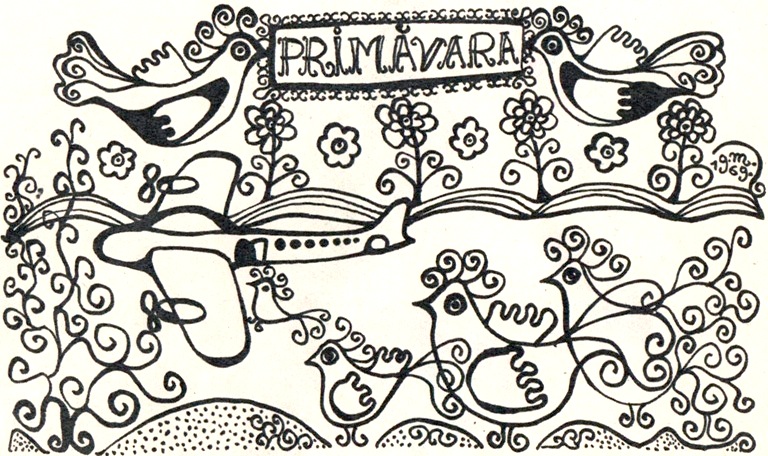Born in Timișoara, he graduated from the University of Plastic Arts of Timișoara in 1965. In 1969 he moved to Bucharest where he continued to pursue his passion for plastic arts and experimental films and where he became a known journalist and filmmaker as well.

Gelu Mureșan was a member of the Cineasts Union from Romania (1974), member of the Union of Professional Journalists in Romania (1992) and a founding member of the Romanian Cultural Foundation ETHNOS (1993).
Gelu Mureșan was a full-time employee at the National Romanian Television (“TVR”) between 1990 and 2001 as an Image Director, Reporter, Story Editor and Artistic Director at the following departments: Spiritual Life and Traditions. At the International Romanian Television Studio (“TVRi”) he made TV documentaries and different TV shows, wrote scripts for documentary films, artistic films, animation films and experimental films.
Between 1962 and 1968 he activated within the House of Culture of Students from Timișoara, making various shows as a host, script writer and director. At the student Film society Cineclub GAUDEAMUS he made a film series (experimental artistic animated) of short films: The fall (“Căderea“), The Legend (“Legenda“), Sacrifice (“Sacrificiu“) and others.
At the Film society Cineclub C.F.R. Timișoara he made the film The Obsession (“Obsesia“), The Hypothesis (“Ipoteza“), experimental films and investigation films. He also studied various techniques of cinematographic art: special effects on film, stunts and animation including combined filmming – the film The Legend (“Legenda“).
Gelu Mureșan in The Obsession (“Obsesia”) Film
He made scientific and medical films for the Timișoara Medical Institute, press photography, advertising graphics, paintings, graphic, Nitrography (his own invention), effects, plastic creation, religious paintings. He was an active collaborator of the Plastic Artists Union from Timișoara.
Between 1963 and 1967 he made advertising graphics and caricatures for the newspapers DRAPELUL ROŞU, NEUER WEG and SZABAT SZO. He also wrote news, articles and notes as a collaborator for the newspaper NEUER WEG.
Between 1966 and 1967 he was employed as a graphic designer by the former MATEI MILLO Theater of Timişoara where he made various posters and scenography.
In 1967 he worked for the Puppet Theater of Timişoara as a technical director.
Between 1968 and 1971 he was The President of The Youth Committee of the Plastic Artists Union from Timiș County Romania (Timișoara). He participated at many art exhibitions between 1965 and 1970. He also worked for Fondul Plastic and he made various art works including mosaic and religious mural paintings.
Between 1969 and 1972 he made at the ANIMAFILM Studio from București, three animation films as a script writer, artistic director, graphician, head animator and scenographer: The spring (“Primăvara“), The fence (“Gardul“) and The stick (“Bagheta“).

Starting with the year 1968 and until 1990 he was a collaborator of the Romanian National Television (“TVR”) – as a freelancer he made shows, short films, special effects, combined filmming, advertising films for Romanian national brands CEC, ONT, Centrocoop and RECOM. He collaborated for the departments TV Films, Musical Varieties, Children-Youth, The Hungarian edition and Culture of the Romanian National Television (“TVR”).
Between 1969 and 1970 he made a short “pirate” film “START IN BALANSOAR” on 35 mm film without any official approval from the studios involved: ANIMAFILM, BUFTEA and SAHIA FILM – Bucureşti. The film was viewed outside the “official selection” of the WESTDEUTSCHE KURZFILMTAGE – OBERHAUSEN Festival. Gelu Mureșan was invited as a special guest at this festival but he couldn’t be there because his passport was declined at that time by the Communist regime.
Between 1970 and 1974 he collaborated with Sahia Film Studios – Bucureşti.
Between 1970 and 1990 he was also a collaborator of the Romanian Radio Broadcasting Company (“Radiodifuziunea Română“).
Between 1970 and 1991 he was a professor and film instructor of Cinematography and Cinematic techniques for the following Film societies: Cineclub FILM 16 of N.Bălcescu House of Culture, Cineclub HERMES, Cineclub ECRAN-CLUB, ATENEUL TINERETULUI and Cineclub ECRAN-UTIL. The films made by these Film societies received many diplomas and awards at national and international film festivals.
Between 1986 and 1990 he was an employee of the former ICSITMUA (The Scientific Research Institute and Engineering Technology for Agricultural Machinery and Equipment) where he made research films, advertising clips and special high-speed camera filming.
Exhibits, Awards & Achievements of Gelu Muresan:
- 1965 – Personal Graphic Exhibition – Timișoara – The medical Institute;
- 1966 – Personal Plastic-Graphic Exhibition at the Bacău Art Gallery;
- 1966 – Participation at the 3rd edition of Scenography Bucharest with the poster for the play I’m not the Eiffel Tower (“Nu sunt Turnul Eiffel“) – C.Oproiu;
- 1968 – He participated at the National Student Art Festival from Romania where he was awarded as the Best Director for three short films – cartoon – artistic experimental and animated objects: The fall (“Căderea“), “Postuma” and Sacrifice (“Sacrificiu“). The film “Postuma” also received the Award of the Cinema Critics;
- 1968 – He invented the technique called Nitrography – premade cliches which can be used in posters, plastic art elements and in film sets – the film The fence (“Gardul“) made in 1970 at ANIMAFILM București and the film The concert (“Concertul“) made in 1974 at the Film society Cineclub FILM 16 București. The film The concert (“Concertul“) participated in 1995 in an Exhibition of Experimental Artistic Films from the Eastern Europe in the Communist Period at the cultural center BEAUBOURG – Paris (the selection was made by KINEMA IKON – Arad). The technique Nitrography was presented by the magazine NEUE LITERATUR and by the newspaper NEUER WEG in a cronic regarding plastic art exhibitions;
- 1969 – The film The Obsession (“Obsesia“) received the First Prize at the experimental artistic category at the National Film Societies Festival from Bucharest;
- 1969 – The 2nd award and a mention to the National Scripts Contest for the film scripts The fence (“Gardul“) and “Postuma“;
- 1969 – He made the action film Bye, bye Fifi (“Adio, Adio, Fifi“) – a short film on 16mm film which was presented at the International Film Festival BRNO – ‘70s;
- 1970 – He participated at the Anual Saloon of Plastic Artists – Timișoara with plastic art works;
- 1970 – He participated at the International Film Festival – Bilbao Spain with three films: The Obsession (“Obsesia“), The fall (“Primăvara“) and “Postuma“;
- 1970 – He participated with the film The fence (“Gardul“) at the International Film Festival Mamaia ’70s but it wasn’t awarded due to the political message of the film. Gelu Mureșan was mentioned in “The International Hollywood Reporter” at that time: “During the last years the ANIMAFILM Animation Studio from București expanded by co-productions with France, Italy, Federal Republic of Germany. We mention some of the best known Romanian animators: Ion Popescu Gopo (SĂRUTĂRI), Gelu Mureșan (GARDUL) …”;
- 1969 – 1971 – He made drawings and caricatures, dedicated articles, film crtitics (AMFITEATRU magazine), illustrations for the magazine of the International Animation Film Association;
- 1971 – He made the graphics for the book with the title Pasiuni pe 16 mm (“Passions on 16 mm“);
- 1972 – The film The fence (“Gardul“) which was presented at the International Meeting Abanoterme – Italy (1971) and other events in Belgium, Finland and USA receives at the Vienna Film Festival – the award for exceptional artistic qualities;
- 1972 – 3rd prize at the International Festival of Festivals from Gyor – Hungary for the film The Obsession (“Obsesia“);
- 1972 – Participation at the International Exhibition of Plastic Film with a drawing for the film The conductor (“Dirijorul“) which was made by ANIMAFILM Studios with the title The stick (“Bagheta“);
- 1974 – He became a member of the Cineasts Union from Romania as a professional;
- 1974 – He became a collaborator mainly for the National Romanian Television (“TVR”) – making artistic and documentary films, commercials, TV shows;
- 1977 – He was a member of the jury at the International Animation Festival, Bielsko-Biala, Poland;
- 1984 – He directed the animation film ANTI-WARRIOR (“ANTI-RĂZBOINICA“) and made also the scenery and the set for it;
- 1985 – 1988 – He directed and made the animation and combined filming for the cartoon series Musical Seasons (“Anotimpuri muzicale“) – 7 episodes of 10 minutes each;
- 1973 – 1990 – He made drawings, graphic art works, paintings in various techniques, engravings and Orthodox Icons;
- 1993 – 1994 – Expo Dracula – Handmade Engravings with the theme Dracula were exhibited in 1993 in Târgu Jiu and in 1994 in Timișoara;
- 1990 – 2002 – He made documentary films for the Spiritual Memories series (“Memorii Spirituale“) about Dracula and Constantin Brâncuși. The documentary film Vlad The Impaler – Dracula (“Vlad Țepeș – Dracula“) made in co-production with the International Romanian Television Studio (“TVRi”) was broadcasted by the National Romanian Television (“TVR”) and the Canadian Broadcasting Corporation;
- 2003 – 2010 – He made drawings, graphic art works, paintings in various techniques including oil on canvas;
- 2005 – He wrote the DADA theater play script KNOMMETENCHIFARCFEQUIFACHEUX;
- 2007 – He published the book “Brâncuşi şi Grădinile Iniţiatice” in a very limited edition;
- 2008 – He wrote the DADA poetry book Anemocorde;
- 2009 – He made several public art sculptures in Mizil City Center, Prahova County, Romania.
The concert (“Concertul“) Film
In collaboration with UNESCO Gelu Mureșan made several documentary films: Avram Iancu and Wooden churches of Transylvania and Maramureș. These films were viewed at the UNESCO Headquarters from Paris, France.
In the book Experiment in Romanian Art since 1960 (“Experimentul în arta românească după 1960“), Meridiane Publishing, Bucharest, 2003, ISBN 9733304840, the well known art critic Alexandra Titu and a good friend of Gelu Mureșan writes about him and his achievements from the ’60s in Timișoara (p. 78, 161).
Gelu Mureșan has art works located in private collections in Romania, France, Germany, Italy, USA and Pakistan.
Gelu Mureșan was not a member of any organized political party, not even on the Communist regime.